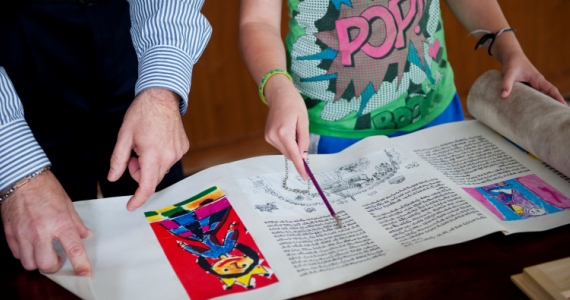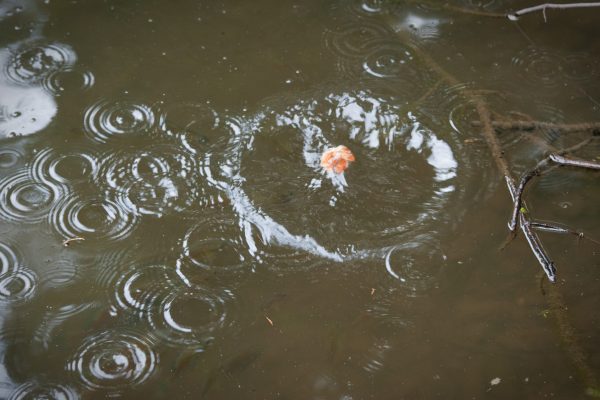In recent years, Jewish women have begun to re-examine the story of Queen EstherHeroine of the Purim story and Megillat (the scroll of) Esther. She is married to the king by her cousin Mordecai and ultimately saves her people from execution. and ask questions about its messages to women. Many women who spent their childhoods donning the pink frills of a Queen Esther costume and shunning the arrogance and disobedience of Queen VashtiIn the Purim story, she is King Ahashveros's first wife. In the first chapter of the Book of Esther, Quieen Vashti refuses to dance for the King and is banished. Long villainized, Vashti has been recently embraced by Jewish women as a contemporay feminist heroine for her defiance of the king. have reclaimed both characters as role models for different types of women’s leadership. Vashti has emerged as an example of a free-thinking, defiant and strong woman who refuses to be objectified by the men in power around her. Esther’s story is read as describing a process by which a woman seizes the potential of her power and becomes a confident and courageous leader, transformed from a voiceless, timid beauty queen.
But conflicting messages about women’s worth still surround Esther and Vashti and fill the pages of the MegillahLit. Scroll Usually refers specifically the Scroll of Esther (Megillat Esther) read on Purim, telling the story of how Esther saved the Jewish people. Megillat Ruth is read on Shavuot.. Women are rewarded throughout the story for their physical beauty as judged by the king and his advisors – all men. The infamous pageant that determines who will hold the highest position of power for women in the kingdom measures women’s beauty as the sole determinant of their value. All of the young virgins of the land are pitted against each other, in a competition that measures how capably each has completed the prescribed twelve month beauty treatment – “six months with oil of myrrh and six months with perfumes and women’s cosmetics” (Esther 2:12).
Whether or not they understood it, the young women of Persia were being taught that their beauty was the key to political and economic success. Today, popular culture sends similar messages to women and girls. Despite the progress made by women in both public and private spheres, Americans still revere “Miss America” but have yet to elect a woman president. Eating disorders are epidemic among young women while millions of dollars are spent annually to convince women that if they were a little thinner, their skin a little tighter, their legs a little longer, they would be more valuable and successful human beings. The media continues to produce and sell images of women with unrealistic bodily proportions despite the fact that these images have been shown to hurt the self-image of women and girls. Depictions of women as submissive in suggestive violent and sexual situations on pages of magazines and billboards perpetuate a culture of violence against women and teach a new generation of teenagers – young men as well as young women – that women are objects of desire and pleasure, not self-respecting individuals.
How can we transform PurimLit. "Lots." A carnival holiday celebrated on the 14th of the Jewish month of Adar, commemorating the Jewish victory over the Persians as told in the Book of Esther. Purim is celebrated by reading the megilla (Book of Esther), exchanging gifts, giving money to the poor, and holding a festive meal. At the megilla reading, merrymakers are dressed in costumes, people drink, and noisemakers (graggers) are sounded whenever the villain Haman's name is mentioned. into an opportunity to bring attention to deeply ingrained societal perceptions of women and to take action towards new and healthier understandings and representations of women’s beauty? As women and girls, mothers and sisters, fathers and sons, friends and lovers of women, how do we prevent ourselves and the women we love from ingesting the harmful messages about women’s beauty and self-worth embedded in our tradition and our culture?
Below, you will find some suggestions for creating a Purim program that will initiate dialogue in your community around these issues. Use a few or all of them with the text of the Megillah to raise questions among the women and men in your family, Hillel, youth group, classroom, Rosh ChodeshThe new moon, which marks the beginning of the Jewish month. According to tradition, because women did not participate in the sin of the golden calf, they were given the holiday of Rosh Chodesh. It is customary for women not to work on Rosh Chodesh. group, women’s collective, etc. If you are not part of a pre-existing group, bring together a group of teenagers, young women, mothers and daughters or other cross-generational group.
Studying Text
Choose one or two passages from the Megillah that feature Esther and Vashti to study as a group or in pairs (chevruta study). Think about the following questions:
- What adjectives are used to describe the women characters? The male characters?
- What actions do the women characters take? Which actions are rewarded? Which are not?
- Are there hints in the text to tell us how the women feel about themselves? If so, what are they? If not, how do you think they feel? Discuss a few possibilities.
- Read Word Collage. What connections can you make between the words of the Megillah and the passages written by contemporary women?
Creating Art
Gather fashion and beauty magazines. Begin by taking a few moments as a group to flip through them and react. Notice the number of pages filled with images of “perfect” women. Notice how thin they are and how flawless their skin is. Notice how many images of women appear in each magazine. What would be left of the magazine if these ads were removed? What stands out about the way that women are dressed, posed and positioned in relation to men? Compare and contrast the purpose of the ads (the product they sell) with the images they present. How do advertisers use images of women’s bodies and lives? Are there other ways to sell these products? Use the magazines to complete one of the following art projects:
- Cut out images from magazines and design collages on the back of postcards. Send the postcards to a target in the fashion industry (See Taking Action below).
- Make Purim masks. Decorate the outside of the masks with images that represent your faces or roles in the public world and the inside of the mask with symbols that depict more hidden parts of your identity and how you see yourself.
- Have participants construct pieces of a larger group collage. For example, design a large, two-or three-dimensional woman covered with images from beauty magazines. Create smaller collages that counter mainstream messages about what women “are made of.”
- Cover the surface of a mirror with a collage of fashion ads to symbolize how women’s self-images are clouded by societal depictions of beauty.
- Choose images that represent the way in which the men of Persia perceived Vashti and Esther. Then try to construct images that represent the women you think Vashti and Esther really were.
Taking Action
- Have participants write postcards to targets in the fashion industry – magazines, newspapers, television networks, etc. Supply sample statements, addresses and stamps but encourage women to write their own thoughts. Have participants commit to respond to at least two ads that they find offensive in the next six months.
- If you are on a campus, consider setting up a display or performance. If you are part of a youth group, design a presentation for synagogues in your area. Raise money at your event for a specific group that combats eating disorders, domestic violence or rape.
- Invite a member of a local feminist organization to talk about her work and the effects of popular culture’s representations of women. Invite participants to contribute money, sign up to volunteer or commit to spreading the word about the work of the organization.
- Make sure that local press covers your action and event. Take pictures, write a press release, submit your own article to organizational newsletters and/or newspapers.
From the Ma’yan Journey, Winter 2001












